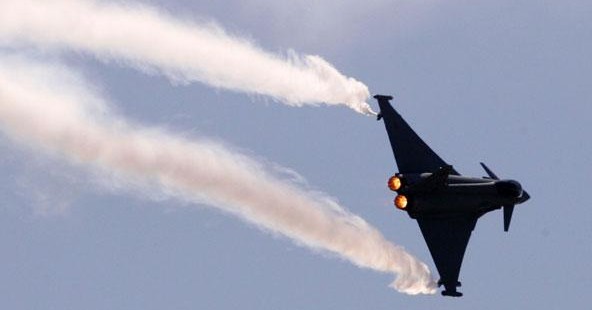
India’s Multibillion-Dollar Message to America
India’s recent rejection of bids from two American jet manufacturers for the biggest defense contract in Indian history made minor news in the U.S. The rest of the world paid closer attention because that decision shot down a dozen years of diplomacy intended to make India another of Washington’s “strategic partners.” It also signaled that one more chapter of the “Pax Americana” story has drawn to a close.
The deal to sell the Indian Air Force 126 fighter jets was a top-tier priority for the Obama administration, and the president lobbied hard for it when he visited New Delhi last November. Timothy J. Roemer, Obama’s ambassador to India, resigned as soon as U.S. defense contractors fell out of the running in late April.
The U.S. loss of $11 billion worth of business (and a commensurate number of American jobs) is troubling, especially since Boeing and Lockheed Martin lost out to Dassault, the French aerospace company, and Eurofighter, a consortium that operates in a cross-border fashion similar to Airbus Industrie.
Some defense and security mavens think New Delhi has blundered, and the conversation in the blogosphere has been heated. “Is the United States more likely to be sympathetic to India’s interests after an $11 billion contract — which means much-needed jobs for the U.S. economy — is awarded to someone else?” asks Nitin Pai, an Indian defense analyst, in a blog post. “Long used to complaining that the United States doesn’t care for India’s interests, will awarding the contract to some European firms help change the situation?”
Good questions. The interesting thing about them is that the Indian government doesn’t appear to be much concerned about the answers.
The Indian Air Force and the Defense Ministry insist that the Europeans simply beat the Americans on technological grounds. And analysts in Washington acknowledge that Boeing (F/A-18) and Lockheed (F-16) were not putting their most advanced technologies on offer.
There is also the Pakistan factor, which Indians are hyper-touchy about: American jet manufacturers already supply the Pakistani air force.
There’s a lot of history behind this deal, too. India’s foreign and defense policies have been marked since independence in 1947 by what used to be called “non-alignment” between East and West. The Cold War is over and the term has fallen out of fashion, but India, now as then, still prefers good friendships and autonomy to undue dependence on other powers. “In the contemporary geopolitical environment, India’s interests are best served by being a swing power,” Nitin Pai says in his blog; Pai is an Indian but pronouncedly a pro-American Indian.
Washington has been assiduously courting New Delhi since the Clinton administration. In the late 1990s, Bill Clinton flew to New Delhi to make sweeping statements about the bright future of the natural alliance between “the world’s two largest democracies.” Three years ago, President George W. Bush signed a civilian nuclear pact that, in essence, welcomed India into the club of nuclear powers.
U.S. intentions have been two. India was supposed to become a strategic counterweight in Asia to China’s supposedly worrisome rise as a global power. As the jet-fighter deal suggests, the Indians were also supposed to buy a lot of American defense hardware.
I see three miscalculations in this superficially neat formulation:
• India is not interested in becoming anybody’s counterweight to anybody else anywhere. Specifically, its efforts in Asia now are gradually to repair what have often been troubled relations with China.
• Happy talk in front of the Indian parliament and offers of a strategic partnership do not translate into top-dollar defense deals. As Ashley Tellis, a security analyst at the Carnegie Endowment for International Peace, said after the Boeing and Lockheed bids were dropped, the intent was “to invest in a plane, not a relationship.”
• Everyone is watching as China continues to gather steam economically and amass more influence as an Asian power. But few share the view, widely held by many Americans, that there is danger inherent in this. China’s rise is inevitable, and Beijing has done nothing to suggest that its intentions extend beyond keeping its economy going at warp speed and winning the world’s recognition as a regional and global player. India, incidentally, shares the same ambitions.
Despite the disappointment over the jet fighter deal, no one is suggesting any new frost gathering in U.S., although the Obama administration has not been shy in expressing its disappointment. But Washington has plainly discovered that there is a limit to its attraction to rising powers such as India: It has some, but history has taken us beyond the only-game-in-town, sole-superpower phase.
One ancillary dimension to this affair: It did not go unnoticed around the world that Roemer, the American ambassador, stepped down — officially for personal reasons — as soon as Boeing and Lockheed fell out of the race. It’s unseemly that diplomats may be reduced to something akin to account executives at ad agencies in the 21st century. But in this era of cutthroat competition to create jobs for your citizens, losing a big account that even the boss has gone to bat for doesn’t go down well in the oval-shaped corner office. “We made a big push,” says a security adviser in Washington who cannot be named because of his institution’s rules, “and we came out looking pretty pathetic.”

